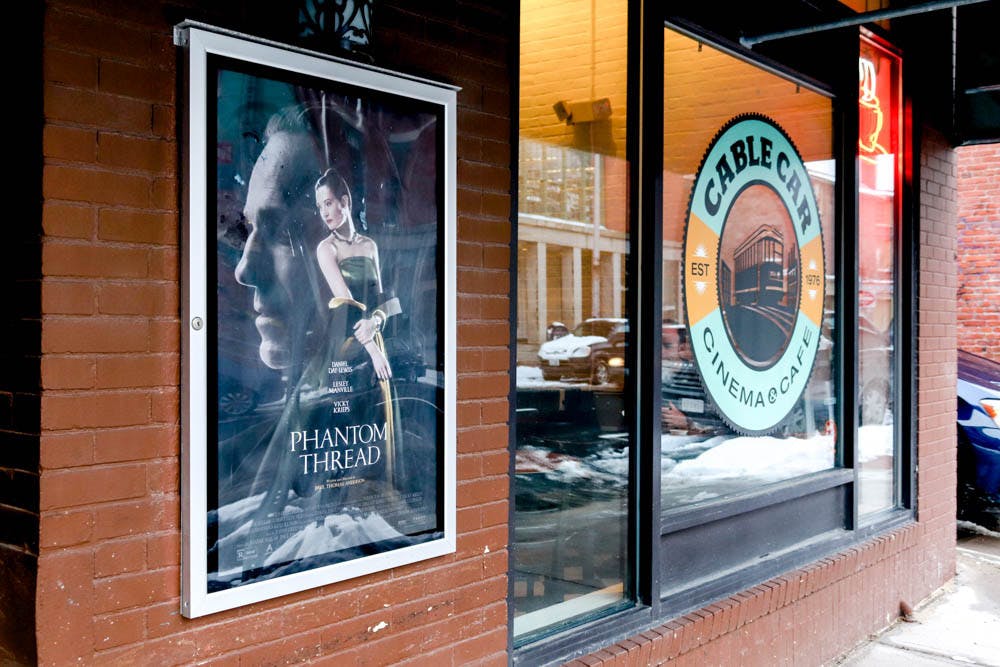The toxicity of love can be strangely appealing — whether experienced directly or vicariously. Naturally, this does not hold true for all romances — indeed, it would not appear to hold true for most. Yet “Phantom Thread,” currently playing at Cable Car, explores a paragon of this mysteriously enticing je ne sais quoi born of a largely twisted relationship.
Directed by Paul Thomas Anderson, the film stars Daniel Day-Lewis as Reynolds Woodcock — a dominating, fastidious and obsessive dress designer in the 1950s in England, who almost defines peculiarity. Living in a realm of elegance, haute couture, models and muses, Reynolds’ life comprises a range of eccentric habits. He sews secret messages into the lining of his dresses, he only consumes asparagus when prepared with oil — asparagus cooked with butter is sacrilege — and his mornings must be marked by utter silence. Needless to say, it isn’t in the least surprising when he describes himself as a “confirmed bachelor.”
When Reynolds meets Alma (Vicky Krieps) — a waitress, who soon takes on the role of his muse — his meticulously structured world is threatened. Though dominated by Reynolds at first, Alma soon emerges from a position of submission with a force that matches his control and authority. What may have initially been construed as one of Reynolds’ passing fancies transforms into an established relationship and then marriage. But their romance is paradoxical, characterized by the warmth of affection, love and desire, alongside icy inhospitality, sin and unhealthy obsession. Without giving too much away, there is a distinct element of sadomasochism in their dysfunctional interactions that cannot be missed.
The film’s plot is fairly straightforward, navigating the evolution of Alma and Reynolds’ relationship. But the questions it raises are far from simple. Anderson examines a plethora of psychosexual, moral and philosophical issues that stem from the duo’s relationship, which continue to engage the viewer long after the film ends. Yet the explorations of “Phantom Thread” go beyond the protagonists’ unconventional romance. Indeed, Anderson leverages their relationship as a tool to subtly introduce a melange of topics, ranging from the power dynamics of gender roles to the purpose of art.
The success of “Phantom Thread” largely revolves around the performances of Day-Lewis and Krieps, who embody their characters and concretize their respective idiosyncrasies flawlessly. Brilliant dialogue and sardonic wit mark their interactions, and their non-verbal communication is no less impressive. While the spotlight is focused on Reynolds and Alma, one must not dismiss the significance of a third character: Reynolds’ sister, Cyril, who runs his fashion business in addition to overseeing his routine — and essentially his life. Portrayed beautifully by Lesley Manville, Cyril has a tart expression permanently tattooed upon her visage and exudes impeccable coldness. Her comportment and eerie omnipresence — which bear an uncanny resemblance to those of Mrs. Danvers in Daphne du Maurier’s “Rebecca” — never fail to tacitly command authority.
The cinematography in “Phantom Thread” is stunning and exquisitely portrays the distinct world that the characters inhabit. Anderson’s camera captures an array of textures, colors and tones with detail that lends an element of almost hyperrealism to the mundane. The costume design is incredible, too — Reynolds’ garments are breathtaking and even ordinary clothing worn by the characters has been designed to fit the period impeccably. Anderson’s artistry is also complemented well by Johnny Greenwood’s musical score, which features a spectrum of genres. Dominant through the film, Greenwood’s music successfully captures a range of moods and mimics the transformation of Reynolds and Alma’s tumultuous love.
“Phantom Thread” is guaranteed to rivet most spectators. Despite its dark and unconventional facets, the film is hard to criticize. In terms of aesthetics, performance and originality, it is an absolute feast.





